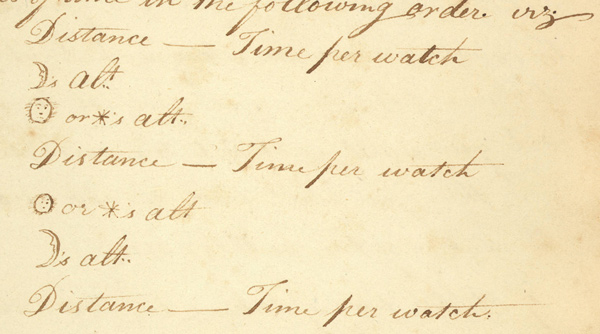Lewis and Clark made celestial observations at “all remarkeable points on the rivers.” Hassler was selected to complete the longitude calculations from that data, but he never finished the job. Jefferson was not satisfied.
—Robert N. Bergantino in Jefferson’s Debt Paid at Last
Here, Robert Bergantino transcribes and analyzes the Astronomy Notebook given to Lewis as a primer for making celestial observations and calculating latitude. He also describes Hassler’s difficulties calculating longitude from Lewis’s data sets and explains Lewis’s methods and results from nine significant locations along the historic Lewis and Clark Trail.
The Astronomy Notebook
Lewis's workbook
by Robert N. Bergantino
Known now as the “Astronomy Notebook,” this extraordinary document has been an obscure and often neglected detail in the history of the Lewis and Clark Expedition. Transcribed in full with commentary by Robert Bergantino.
Jefferson’s Debt Paid at Last
Introduction to "Deciphering the Celestial Data"
by Robert N. Bergantino
Lewis and Clark made celestial observations at “all remarkeable points on the rivers.” Hassler was selected to complete the longitude calculations from that data, but he never finished the job. Jefferson was not satisfied.
The Kansas River Observations
27–29 June 1804
by Robert N. Bergantino
Celestial observations at the Kansas and Missouri river confluence began shortly after 8 a.m. on 27 June 1804. The first observation would provide the data necessary to calculate the magnetic declination.
The Fort Mandan Observations
22 December 1804–3 April 1805
by Robert N. Bergantino
In January 1798, Thompson took celestial observations at the villages and determined them to be at a latitude of 47°17’22″N and a longitude of 101°14’24″W. Why then did Lewis and Clark think it necessary to take twenty-six observations?
The Marias River Observations
2–10 June 1805
by Robert N. Bergantino
It was a clear night. The moon, just two days short of its first quarter, was 23° above the horizon bearing S78° W when the captains began their observations about 9:30 p.m.
Missouri Headwaters Observations
28–29 July 1805
by Robert N. Bergantino
On 28 July 1805, while a fever-ridden Clark drew maps, Lewis began his celestial observations. By late night on 29 July, Lewis had completed ten discrete celestial observations consisting of a total of forty-eight separate angular measurements.
Fortunate Camp Observations
18–21 August 1805
by Robert N. Bergantino
If, as suggested, Fortunate Camp was at 44°59’36″N, how did Lewis, after averaging four observations, come up with a latitude 24 minutes too far south?
Clearwater Canoe Camp Observations
30 September–6 October 1805
by Robert N. Bergantino
Determining the latitude of a location from a meridian observation of the sun is among the simplest celestial observations to take and to calculate. On 5 October 1805, Clark writes: “Latitude of this place from the mean of two observations is 46°34’56.3″ North.”
The Snake-Columbia Confluence Observations
17–18 October 1805
by Robert N. Bergantino
On 17 October 1805, at the junction of the Snake and Columbia rivers, Lewis set out the artificial horizon and got the sextant out of its case. One of the men stood by with the chronometer, ready to read and record the time of Lewis’s measurements.
The Station Camp Observations
16–24 November 1805
by Robert N. Bergantino
The morning of 16 November 1805 dawned “Clear and butifull.” At noon Clark took advantage of the conditions and made an observation of the sun’s altitude for latitude. He used the sextant and artificial horizon.
Long Camp Observations
25 May–9 June 1806
by Robert N. Bergantino
An analysis of Lewis’s celestial observations made during their stay at Long Camp near present-day Kamiah, Idaho.
Experience the Lewis and Clark Trail
The Lewis and Clark Trail Experience—our sister site at lewisandclark.travel—connects the world to people and places on the Lewis and Clark Trail.
Discover More
- The Lewis and Clark Expedition: Day by Day by Gary E. Moulton (University of Nebraska Press, 2018). The story in prose, 14 May 1804–23 September 1806.
- The Lewis and Clark Journals: An American Epic of Discovery (abridged) by Gary E. Moulton (University of Nebraska Press, 2003). Selected journal excerpts, 14 May 1804–23 September 1806.
- The Lewis and Clark Journals. by Gary E. Moulton (University of Nebraska Press, 1983–2001). The complete story in 13 volumes.

